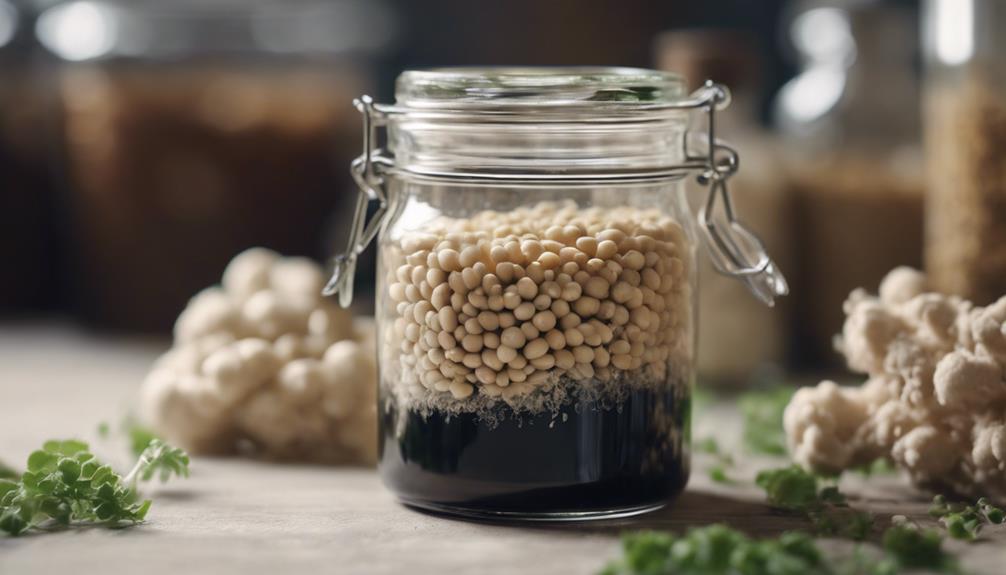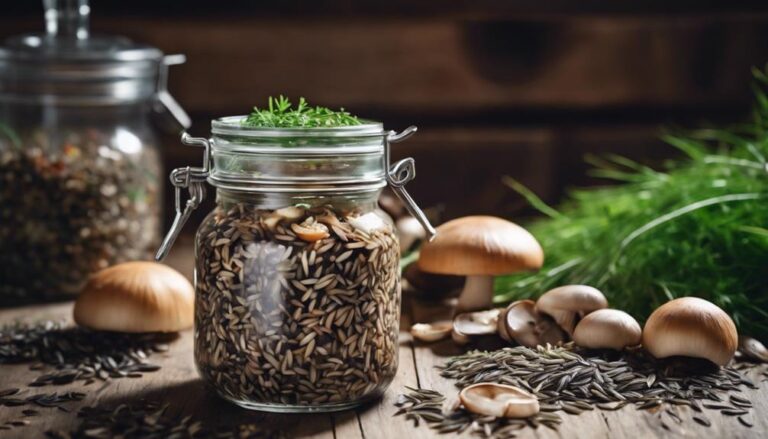Sous Vide Balsamic Glazed Tempeh Steaks
Immerse tempeh steaks in a sous vide bath for precise cooking control. The balsamic glaze enriches tempeh's nutty flavor. Sous vide enhances tempeh's taste and nourishing qualities.
What You Will Learn Here
- Sous vide cooking ensures precise temperature control for perfectly cooked tempeh.
- Balsamic glaze enhances the nutty flavor profile of tempeh steaks.
- Tempeh steaks hold up well to sous vide, maintaining a moist and tender texture.
- Sous vide technique infuses flavors into tempeh for a delicious plant-based meal.
- This method showcases the versatility of plant-based cooking with sous vide tempeh steaks.
Tempeh's Indonesian Origins

Tempeh, known for its Indonesian origins, has a rich history in traditional Indonesian cuisine.
The fermentation process of tempeh, involving specific Rhizopus cultures, contributes to its unique flavor profile.
Understanding the cultural significance of tempeh sheds light on its long-standing presence in Indonesian culinary traditions.
Indonesian Tempeh History
Indonesian culinary heritage reflects a longstanding tradition of fermenting plant-based proteins to enhance both preservation and nutritional qualities. Tempeh, originating in Indonesia as a traditional fermented food made from soybeans, has been enjoyed for centuries, dating back to the 12th century. The fermentation process historically aimed at preserving soybeans and improving their digestibility.
This staple in Indonesian cuisine is renowned for its rich umami flavor and nutritional benefits. While soybeans are the typical base for tempeh, regional variations may incorporate other grains or beans. The history of Indonesian tempeh signifies a heritage deeply rooted in the art of fermentation, creating a versatile and nutritious ingredient enjoyed worldwide.
Tempeh Fermentation Process
Investigating the origins of tempeh production reveals the intricate fermentation process that defines its Indonesian roots. The fermentation process of tempeh involves the controlled growth of Rhizopus oligosporus or Rhizopus oryzae cultures on soaked and cooked soybeans. This fermentation binds the soybeans into a firm cake-like structure, enhancing their nutritional value and digestibility. The tempeh fermentation process also imparts a unique earthy flavor profile with subtle nutty undertones. The use of sous vide cooking techniques allows for precise temperature control during fermentation, ensuring ideal conditions for the growth of beneficial mold. Here is a table summarizing key points about the tempeh fermentation process:
| Aspect | Details |
|---|---|
| Fermentation Duration | 24-48 hours |
| Optimal Fermentation Temp | 30-31°C (86-88°F) |
| Fermentation Container | Perforated plastic bags or banana leaves |
| Fermentation Outcome | Firm cake-like structure with a nutty flavor |
| Cultures Used | Rhizopus oligosporus or Rhizopus oryzae molds for fermentation |
Cultural Significance of Tempeh
Originating in Indonesia, tempeh holds a revered status as a traditional fermented food rich in cultural significance. Indonesian cuisine embraces tempeh as a staple, highlighting its high protein content and versatility in various dishes.
The essential fermentation process for tempeh production involves using specific mold cultures like Rhizopus oligosporus or Rhizopus oryzae. Beyond soybeans, Indonesian tempeh recipes may incorporate ingredients such as barley, grains, or beans for added complexity.
The nutty flavor, firm texture, and nutrient density of tempeh reflect its importance in Indonesian culinary traditions. This culturally significant food item not only showcases the country's culinary heritage but also provides a valuable protein source with a unique taste profile, making it a beloved ingredient in Indonesian cooking.
Tempeh's Fermentation Process Ingredients

Tempeh's fermentation process involves introducing a tempeh starter culture into cooked and dehulled soybeans to facilitate the growth of beneficial molds. These molds play a vital role in binding the soybeans together and transforming them into a solid tempeh block.
Here are some key ingredients involved in the fermentation process:
- Cooked and Dehulled Soybeans: The primary ingredient that serves as the base for tempeh production.
- Tempeh Starter Culture: Contains beneficial molds like Rhizopus oligosporus or Rhizopus oryzae, essential for the fermentation process.
- Incubation Temperature: Fermentation occurs at around 88 degrees Fahrenheit, providing an ideal environment for mold growth.
- Incubation Time: Typically takes 30-36 hours for the fermentation process to complete.
- Barley or Other Legumes: Besides soybeans, tempeh can also be made using barley or other legumes, offering variations in flavor and texture.
Understanding these ingredients is fundamental when preparing tempeh using a traditional fermentation process.
Tempting Tempeh Creations
When considering tempting tempeh creations, you may explore a variety of options to elevate your plant-based culinary repertoire.
Try crafting a flavorful Tempeh Reuben Sandwich, infusing the classic deli favorite with a nutritious twist.
Experiment with Marinated Tempeh Skewers for a delightful and protein-packed appetizer, showcasing tempeh's versatility in absorbing marinades.
Additionally, immerse yourself in the world of Tempeh Stir-Fry Delight, combining vibrant vegetables and savory tempeh for a satisfying and nutrient-rich meal.
Tempeh Reuben Sandwich Recipe
If you're looking to elevate your sandwich game with a plant-based twist, consider trying the Tempeh Reuben Sandwich recipe for a flavorful and satisfying meal option.
- Plant-Based Twist: Utilize tempeh as a hearty protein base.
- Layered Ingredients: Include marinated and pan-fried tempeh slices, sauerkraut, vegan cheese, and Russian dressing on rye bread.
- Hearty Alternative: Tempeh offers a flavorful substitute for traditional Reuben fillings like corned beef.
- Satisfying Combination: Tangy sauerkraut, creamy Russian dressing, and savory tempeh create a delicious sandwich experience.
- Versatile Tempeh: Showcases the adaptability of tempeh in crafting delicious plant-based meals, ideal for a meatless Reuben sandwich option.
Marinated Tempeh Skewers
To enhance the flavor and texture of your marinated tempeh skewers, contemplate utilizing a diverse selection of spices and herbs for a satisfying plant-based protein option. Marinating tempeh skewers in a blend of olive oil and various seasonings can elevate their taste profile and make them a hit at any gathering. Here are some key elements to contemplate when preparing marinated tempeh skewers:
- Use a mix of herbs such as rosemary, thyme, and oregano for added depth of flavor.
- Incorporate spices like smoked paprika, cumin, or chili powder to provide a hint of heat.
- Include a touch of sweetness with ingredients like maple syrup or agave nectar.
- Experiment with different citrus juices such as lemon or lime for a tangy kick.
- Don't forget to add a dash of salt and pepper to balance the overall taste of the skewers.
Tempeh Stir-Fry Delight
Enhancing both flavor and nutrition, stir-frying tempeh with an array of vibrant vegetables and seasonings creates a delectable Tempeh Stir-Fry Delight.
- Versatile Dish: Tempeh stir-fry is a customizable meal that can incorporate a variety of colorful vegetables.
- Texture Enhancement: Stir-frying helps tempeh absorb flavors while maintaining a satisfying texture.
- Quick Preparation: Tempeh stir-fry is a fast and convenient meal option suitable for busy days.
- Protein-Rich: The high protein content of tempeh makes it a filling choice for a plant-based stir-fry.
- Customizable Flavors: Different sauces and spices can be added to tempeh stir-fry for diverse taste profiles.
Tempeh Preparation Techniques
When preparing tempeh, marinating techniques play a pivotal role in enhancing flavor absorption. Additionally, the method of cooking tempeh will ultimately determine its texture and taste.
Exploring different flavor profiles through various marinades can elevate the overall dish.
Tempeh Marinating Methods
Consider marinating tempeh in a blend of soy sauce, balsamic vinegar, and spices to enhance its flavor and texture effectively. Marinating tempeh allows it to soak up the flavors, enhancing its taste profile.
For a sweet dish, marinate tempeh with maple syrup or honey; for a savory option, try using tamari or miso in the marinade; for a tangy twist, include citrus juices or apple cider vinegar.
Marinating tempeh for at least an hour before cooking is recommended to guarantee the flavors penetrate the tempeh thoroughly. This process not only reduces any bitterness in the tempeh but also adds layers of complexity to the overall flavor profile, making your tempeh dishes more enjoyable and satisfying.
Tempeh Cooking Techniques
To optimize the texture and flavor of tempeh, various cooking techniques can be employed to elevate its taste profile and versatility. Steaming tempeh is a common method used to improve texture and remove bitterness. Essential tempeh is another pivotal step that not only enhances its flavor but also allows for customization based on personal preferences.
Slicing tempeh into desired shapes or sizes can impact its cooking process, influencing factors like absorption of flavors and cooking time. Additionally, tempeh can be baked, grilled, pan-fried, or air-fried to achieve different textures and flavors.
Utilizing proper preparation and cooking techniques can transform tempeh into a versatile and delicious dish, making it a delightful addition to various recipes.
Tempeh Flavor Profiles
For a strong tempeh flavor profile, marinating the tempeh blocks before cooking is essential to enhance both texture and flavor absorption. Tempeh's nutty and mild taste pairs well with a variety of marinades and seasonings. By steaming the tempeh blocks before marinating, you can improve its texture and allow it to soak up flavors more effectively. Different marinades can be used to achieve unique taste profiles; for example, marinating with balsamic vinegar, maple syrup, soy sauce, garlic, and olive oil can add depth and richness to the dish. Cutting tempeh into various shapes and sizes also allows for versatility in culinary applications and serving styles.
| Tempeh Flavor Profiles | |||
|---|---|---|---|
| Nutty and Mild | Enhances Texture | Complements Marinades | Versatile Shapes & Sizes |
Final Thoughts
To encapsulate, the sous vide balsamic glazed tempeh steaks offer a delightful and comprehensive culinary experience that demonstrates the adaptability and potential of plant-based cooking. Sous vide cooking guarantees precise temperature control, resulting in perfectly cooked tempeh steaks with a firm texture that holds up well to this technique.
The addition of balsamic glaze enhances the tempeh's inherent nuttiness, creating a sweet and tangy flavor profile that enhances the dish. This blend of cooking methods and flavors leads to a flavorful and nutritious plant-based meal choice that's certain to please even the most discerning tastes.
Frequently Asked Questions
How Do You Cook Tempeh so It's Not Bitter?
To cook tempeh so it's not bitter, focus on tempeh flavoring. Experiment with different tempeh recipes, using sweet elements like maple syrup and tangy ingredients such as balsamic vinegar to balance and enhance the dish.
Should I Steam Tempeh Before Marinating?
Steaming tempeh before marinating enhances flavor infusion and improves tenderness. This technique allows tempeh to absorb marinades effectively, reducing bitterness and creating a more enjoyable culinary experience overall. It's a common method for preparing tempeh dishes.
Why Boil Tempeh Before Cooking?
Boiling tempeh before cooking enhances its texture, making it more receptive to marinades. This precooking technique softens the tempeh, reduces bitterness, and removes excess moisture. The process improves overall flavor profile, enhancing tempeh benefits.
How Do You Make Tempeh Texture Better?
To enhance tempeh texture, guarantee proper marination for flavor absorption and tenderness. Experiment with slicing thinly for better marinade penetration. Utilize controlled cooking methods like sous vide for consistent results. Vary cooking techniques to suit preferences in tempeh recipes.
Conclusion
To sum up, sous vide balsamic glazed tempeh steaks offer a delectable and nutritious alternative to traditional meat dishes. By leveraging the precise temperature control of sous vide cooking, the tempeh is able to absorb the flavors of the balsamic glaze while maintaining its tender texture.
This innovative technique elevates tempeh to a gourmet level, showcasing its versatility and potential as a plant-based protein source. Immerse yourself in the world of sous vide tempeh and experience a flavorful culinary adventure.











